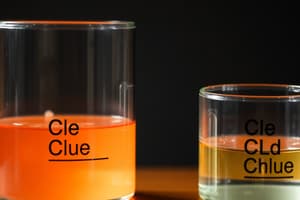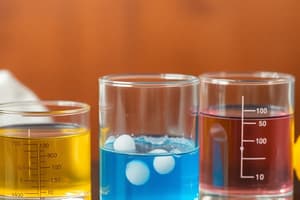Podcast
Questions and Answers
What is the chemical opposite of acids?
What is the chemical opposite of acids?
- Salts
- Acids
- Neutralizers
- Alkalis (correct)
All alkali are bases.
All alkali are bases.
True (A)
Which of the following is a common alkali?
Which of the following is a common alkali?
- Sodium hydroxide
- Potassium hydroxide
- Calcium hydroxide
- All of the above (correct)
What is the chemical formula for sodium hydroxide?
What is the chemical formula for sodium hydroxide?
What is the common name for calcium hydroxide?
What is the common name for calcium hydroxide?
Aqueous ammonia is a colorless gas.
Aqueous ammonia is a colorless gas.
Which of the following is a characteristic of alkalis?
Which of the following is a characteristic of alkalis?
Dilute alkalis turn moist red litmus paper blue.
Dilute alkalis turn moist red litmus paper blue.
What is the chemical formula for hydroxide ions?
What is the chemical formula for hydroxide ions?
Dissociation is the process by which a compound separates into ions.
Dissociation is the process by which a compound separates into ions.
What are two ways that alkalis can react with acids?
What are two ways that alkalis can react with acids?
What is the general ionic equation for the neutralization reaction?
What is the general ionic equation for the neutralization reaction?
The reaction between an alkali and a non-metal oxide always produces water.
The reaction between an alkali and a non-metal oxide always produces water.
What is the chemical formula for carbon dioxide?
What is the chemical formula for carbon dioxide?
What is the name of the salt formed when sodium hydroxide reacts with sulphur dioxide?
What is the name of the salt formed when sodium hydroxide reacts with sulphur dioxide?
Flashcards
Base
Base
A substance that neutralizes acids and has a bitter taste and slippery feel.
Alkali
Alkali
A type of base that is soluble in water.
Sodium Hydroxide (NaOH)
Sodium Hydroxide (NaOH)
A common alkali, often a white solid.
Potassium Hydroxide (KOH)
Potassium Hydroxide (KOH)
Signup and view all the flashcards
Calcium Hydroxide (Ca(OH)2)
Calcium Hydroxide (Ca(OH)2)
Signup and view all the flashcards
Aqueous Ammonia (NH3)
Aqueous Ammonia (NH3)
Signup and view all the flashcards
Bitter taste
Bitter taste
Signup and view all the flashcards
Slippery feel
Slippery feel
Signup and view all the flashcards
Electrolyte
Electrolyte
Signup and view all the flashcards
Litmus paper
Litmus paper
Signup and view all the flashcards
Hydroxide ions (OH⁻)
Hydroxide ions (OH⁻)
Signup and view all the flashcards
Neutralization
Neutralization
Signup and view all the flashcards
Reaction with Non-Metal Oxides
Reaction with Non-Metal Oxides
Signup and view all the flashcards
Ammonium Compound
Ammonium Compound
Signup and view all the flashcards
Ionization
Ionization
Signup and view all the flashcards
Dissociation
Dissociation
Signup and view all the flashcards
Reaction with acid
Reaction with acid
Signup and view all the flashcards
Reaction with non-metal oxide
Reaction with non-metal oxide
Signup and view all the flashcards
Reaction with ammonium compound
Reaction with ammonium compound
Signup and view all the flashcards
Test for ammonium
Test for ammonium
Signup and view all the flashcards
Metal ion in aqueous solution reaction
Metal ion in aqueous solution reaction
Signup and view all the flashcards
Study Notes
Bases
- Bases are the chemical opposite of acids.
- Water-soluble bases are called alkalis. (Not all bases are alkalis)
- Common alkalis include sodium hydroxide (NaOH), potassium hydroxide (KOH), and calcium hydroxide (Ca(OH)₂).
- Sodium hydroxide is a white solid.
- Potassium hydroxide is a white solid.
- Calcium hydroxide (as a pure solid) is a white solid; in an aqueous form is known as lime water.
- Aqueous ammonia is a colorless gas.
Characteristics of Alkalis
- Alkalis have a bitter taste.
- Alkalis feel slippery, reacting with grease to form soap.
- Alkalis are electrolytes, meaning they release ions when dissolved in water.
- Dilute alkalis turn moist red litmus paper blue.
Role of Water in Bases
- When bases dissolve in water, they ionize, producing hydroxide ions (OH⁻).
- This ionization is what gives bases their alkaline properties.
Reaction of Bases (Neutralization)
- A base reacts with an acid to form a salt and water.
- This is known as neutralization.
Reaction of Bases with Non-metal Oxides
- Bases react with non-metal oxides like carbon dioxide (CO₂) and sulfur dioxide (SO₂), producing metal carbonates (or sulfites) and water.
- For example, calcium hydroxide (Ca(OH)₂) reacts with carbon dioxide (CO₂) to form calcium carbonate (CaCO₃) and water (H₂O).
Testing for Ammonium Ions
- To test if a salt contains ammonium ions (NH₄⁺), heat the salt with a base
- A pungent smell of ammonia gas (NH₃) indicates the presence of ammonium ions.
- The ammonia gas will turn moist red litmus paper blue.
Reaction of Alkalis with Salts
- Alkalis react with certain salts to form metal hydroxides and a new salt.
- This reaction can sometimes produce a precipitate.
- As an example, sodium hydroxide reacts with copper(II) chloride to form copper(II) hydroxide and sodium chloride.
Studying That Suits You
Use AI to generate personalized quizzes and flashcards to suit your learning preferences.




